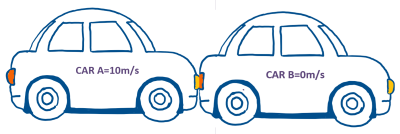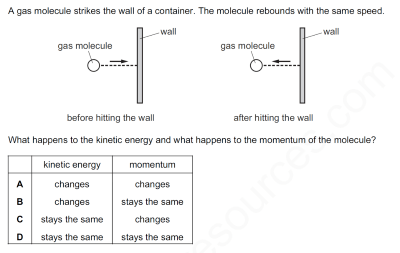
LEARNING OBJECTIVES
By the end of this section, you will be able to:
- know the concept of momentum and impulse
- Recall and use the equation: Momentum=Mass X Velocity ; symbollically, p=mv
- Recall and use the equation for impulse: Ft=mv-mu
- Apply the principle of conservation of momentum to solve simple problems in one dimension.
MOMENTUM:
- Every object has mass. So when an object is moving, then it will obviously have momentum
- Momentum depends upon the variables mass and velocity.
- In terms of an equation, the momentum of an object is equal to the mass of the object times the velocity of the object.
- Momentum = mass • velocity.
- In physics, the symbol for the quantity momentum is the lower case p. Thus, the above equation can be rewritten as p = m • vwhere m is the mass and v is the velocity. The equation illustrates that momentum is directly proportional to an object's mass and directly proportional to the object's velocity.
IMPULSE:
- According to Newtons Second Law
- Hence, F = ma
- But a= (v-u)/t.
- Hence F=[ m ( v-u)] /t
- Or Ft= mv-mu
- Ft is known as impulse. We also know that mv-mu imples change in momentum.
- Hence, impulse is defined as the change in momentum
PRINCIPLE OF CONSERVATION OF MOMENTUM:
- The principle of conservation of momentum states that:
- For two or more bodies in an isolated system acting upon each other, their total momentum remains constant unless an external force is applied. Therefore, momentum can neither be created nor destroyed.
SUMS :
1. The following is an example of of a moving object colliding with a stationary object.
Consider Car A of mass 40 kg moving with Car B of mass 45kg . Car B is stationary. Also let the velocity of Car A =10m/s and that of Car B=0m/s.
1
Now suppose the car A collides with carB as shown below

It is observed that the two cars now together move to the right with a velocity of 6m/s as shown below.
Let us find the mass of carB.
Solution:
For a closed system, the total momentum is always conserved. Hence it is the same before and after the collision.
BEFORE COLLISION:
MOMENTUM OF CAR A
= Mass of car A x Velocity of car A
=40 X10 =400 kgm/s
MOMENTUM OF CAR B
= Mass of car B x Velocity of car B
=Mass of car B X 0 = 0 kgm/s
Hence the total momentum before collision= 400kgm/s
AFTER COLLISION:
Total momentum
= Total mass of car A and B x Velocity of car A and B
=(40+ Mass of car B) x 6
But in a closed system, the total momentum is conserved;
Hence
Total momentum before collision=Total momentum after collision
400= (40+ Mass of car B) x 6
400=(40x6 ) + (Mass of car B)6
400=240 +(Mass of car B)6
400-240=Mass of carB x 6
160=Mass of carB x 6
160/6= Mass of car B
Mass of car B= 26.67 kg
Following is an example taken from IGCSE Past Papers:
MULTIPLE CHOICE SOLVED QUESTIONS-MOMENTUM
QUESTION:1

CORRECT OPTION:C
Explanation:
- After collision, the direction of velocity changes .
- Kinetic energy= 1/2(mv2). Since it is stated that the molecule rebounds with the same speed, hence it implies that the kinetic energy stays the same.
- The momentum after collision changes . This because before collision, it's momentum is +mv and after collision, the momentum changes to -mv. This is because, the direction of veloicty changes form +v to -v
2. Gas molecules striking a container wall cause a pressure to be exerted on the wall. Which statement explains this:
A. When a molecule rebounds , there must be a change in energy.
B.When a molecule rebounds there must be a change in it's momentum
C.When a molecule rebounds, there must be a change in its speed.
D.When a molecule rebounds, there must be a change in it's temperature.
CORRECT OPTION: B
EXPLANATION:
Pressure= Force/Area
= (mass x acceleration)/area
=(mass x (v-u)/time))/area
Pressure={(change in momentum)/time)}/area
Thus a change in momentum will cause a pressure to be exerted on the wall.
3
 (1).png)
CORRECT OPTION :C
Explanation:
- According to the principle of conservation of momentum, the total momentum before impact= the total momentum after impact.
- Total momentum before impact= momentum of the ball + momentum of the object
- Total momentum before impact= (3 x 8) + (3 x 0) = 24 kgm/s
- Hence total momentum after impact= 24kg m/s....As momentum is conserved.
- Once again applying the conservation of momentum:"the total momentum before impact= the total momentum after impact.", we get 24= (mass of ball +Object) x combined velocity=> 24= 5 x combined velocity.
- Hence combined velocity= 24/5=4.8m/s
IGCSE Physics revision notes-Momentum 






 (1).png)

Write a public review